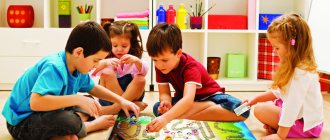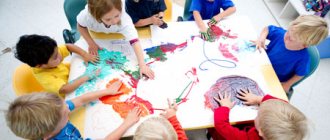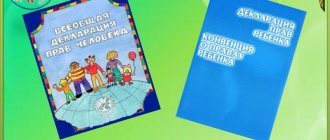Over the past few years in Russia, the number of children injured in road accidents has decreased by 17%, mortality has decreased by 30%, and the severity of injuries in children has decreased by 15%. The general statistics are as follows: every seventh child involved in an accident dies, every third child is injured. Of course, the statistics include all cases of accidents involving children, and, accordingly, among these terrible figures there are many children whose parents were driving in a car without a car seat. But, unfortunately, child pedestrians also die and are injured.
Accidents with children most often occur near playgrounds or in courtyards. The fact is that, due to the peculiarities of perception, until the age of 4, a child does not realize that the car cannot stop instantly, and until the age of 6, he is poorly oriented by sound. For example, a child jumps out onto the road to get a ball, and if at that moment he sees a car, he will simply freeze in place, or even cover his face with his hands. And in this situation, the only way out is to teach the child how to behave safely on the road. “It’s too late to start teaching children how to behave safely on the road from kindergarten,” says Deputy Head of the State Traffic Inspectorate of the Ministry of Internal Affairs of Russia, Police Major General Vladimir Kuzin . “Therefore, preparing a law-abiding road user begins with expectant mothers.”
Experts argue that the system of continuous training of road users should begin with training mothers in maternity hospitals and continue at all stages of a person’s growing up. Only in this way will competent and safe behavior on the roads become the norm. In Russia such a system is already in effect. For its successful and effective implementation, there is only one condition - general coverage.
Question and answer How to dress a child to keep him safe on the road?
By personal example
The first thing that parents, who are the main teachers of children in safe behavior on the road, need to remember is that children do not so much perceive words as they perceive examples. You can constantly tell them that you can’t cross a red light, but once a mother and her child cross the road like that, all the traffic rules lessons will go down the drain. Yes, schools and even kindergartens now devote time to teaching norms of behavior on the streets, but it is not enough. Often such classes are carried out for show. Of course, a 10-year-old boy understands that you can’t cross the road when it’s red, but many of his classmates no longer know how and where to ride a scooter or bicycle correctly.
Young Traffic Inspectors (JIT) have a huge influence on their peers. Members of the JID teams not only learn traffic rules themselves, but also help their peers learn the rules, and often remind adults of the need to comply with them.
“The role of parents is primary. After all, even when we come to kindergarten with educational programs, we see how the child is involved in the process, how he does not want to break the traffic rules and how he knows all the points of behavior on the road. But as soon as a child sees that his parents are calmly breaking the rules and are not hit by a car, he involuntarily begins to do it himself. The entire training system immediately breaks down,” says the head of the YID detachment, Tatiana Okan . – The YID teams are created, in fact, to help organize the prevention of child injuries due to road accidents in schools with the help of the children themselves. We organize various events for both schoolchildren and parents. Children essentially teach each other through play. And I can say that we noticed that in schools where the JID units operate, over a long period of time the number of road accidents involving schoolchildren has come to naught.”
Security laboratory. How to teach modern children traffic rules Read more
Homework
We have already talked about the basics of traffic safety training. In order for a child to be safe on the road, parents must teach him the rules - first the simplest ones, such as “stop on red, go on green”, then more and more complex ones. There are a lot of different books and games for this. But the main thing is that parents are obliged to set an example of compliance with traffic rules. If a child is taught to cross the street only at green traffic lights and at zebra crossings, a dad crossing the road anywhere can undo all the training. However, here you can still think and talk about the general culture and respect (or disrespect) for others, who help or hinder us from following the rules, including on the road.
Children copy the behavior of their parents, it is important to remember this, including on the road.
Children copy the behavior of their parents, it is important to remember this, including on the road.
If your child rides a bicycle, make sure that he does it correctly: dismounts in front of the zebra and crosses, rather than drives, the road, moves on bike paths (where they exist), and wears a protective helmet. And be an example for him.
MSDS
Recently, every school has been required to have a road safety passport. The document includes diagrams of buildings on the school grounds, a plan diagram of the area, where roadways, sidewalks, zebra crossings, etc. are indicated. It also outlines the movement of children on their way to and from the school. Unfortunately, not all schools treat safety data sheets responsibly. Community activists regularly monitor this as part of the “Road to School” campaign. “Often the information in these documents is completely inconsistent with reality. For example, in the diagram posted on the website of a school in Medyn, a road is drawn in the place where the park is located,” says ONF activist in the Kaluga region Vladimir Potapov . – The arrows indicate the movement of children, but on the diagram these arrows are drawn exclusively in front of the school entrance; there are no road signs. This is not the first time we have seen that an electronic road safety passport in schools, unfortunately, turns into an empty document, developed on the principle of “just to be.”
For the safety of the child’s movement on the way from home to school and back, parents need to know how to draw this route on paper as a visual aid. In some educational organizations, this is an official requirement for each student, and the outlined plan is included in the student’s portfolio. The route to school should not necessarily be the shortest, not necessarily the fastest, but certainly the safest for your child.
Question answer
How to properly transport a child in a car?
Before school
Road safety classes are usually included in the educational program of preschool institutions. If your child goes to kindergarten, ask him whether they had classes on traffic rules in their group or not. You can ask the teachers the same and offer to conduct such classes. It doesn't hurt to enlist the support of other parents. This is not difficult to do - each group has its own chat on the Internet.
It would be nice if, based on the results of these classes, a road safety festival is organized - a half-hour performance, with riddles and answers on the topic of traffic rules, competitions, and prizes. This event will require a penny of props and a minimum of time for preparation, but the benefits will be enormous and long-term, especially if not only children, but also parents take part in the holiday.
In a playful way
The Ministry of Education of Russia emphasizes that the primary task of modern school teachers is to explain road behavior tactics in a language understandable to children without distorting the essence, which cannot be achieved without the use of a number of methodological developments that are advisory in nature.
There are many methods for interesting game-based learning. For example, the “City of Roads” portal, created as part of the implementation of the current Federal Target Program. Today in Russia there are almost 40 mobile innovative centers for the prevention of children's road traffic injuries “Safety Laboratory”. In fact, this is a car equipped with bicycles, scooters, models and elements of the road network that allow you to simulate various road situations. The machine itself is also an element of learning. For example, with its help, children are clearly shown the dependence of the braking distance on the speed of the vehicle. “Laboratory” first of all teaches the child to make decisions in specific situations, and not just memorize traffic rules. “There is nothing more important than child safety and child life. Such a mobile complex allows you not only to explain to a child in words how to behave on the roads, pedestrian crossings, in transport, on a bicycle, but with the help of games to simulate situations, understand them from the inside and remember them. In addition, the “Laboratory” is mobile, which means that training can be carried out not only in the city, but also in regional centers and rural settlements,” says Nikolai Lyubimov, governor of the Ryazan region .
Article on the topic
No risk.
School bus drivers will be trained in safe driving “Unfortunately, today not every adult can read the entire collection of traffic rules, and most importantly, understand it. Not to mention the children,” noted the president of the expert Natalya Agre . “Traffic regulations are written in very complex legal language, and it is necessary to adapt them so that everyone can find the answer to their question, so that parents can read and understand them together with their children.”
It's a shame if you can't see it
Parents should ensure that their child’s clothing has any reflective elements. This is especially important right now, when it gets dark early, but snow has not yet fallen everywhere. Practical mothers try to dress their children in something darker that is less likely to get dirty. If you do this and there are no reflective elements on your child’s clothes, buy for him at least a few cheap flickers that can be sewn, glued, or hung on a jacket or backpack. By the way, it doesn’t hurt for adults to acquire similar accessories either. And wearing them shouldn't be a shame.
By the way
- In Syktyvkar, the State Traffic Inspectorate and the Judicial Inspectorate conduct a “Safety Hour” on traffic rules in clinics for young patients and their parents. Children were reminded why it is important to wear reflectors. Yuida members prepared traffic rules tests for parents. All those who answered correctly were awarded memorable prizes.
- In Transbaikalia, Parent Patrol conducts master classes on traffic rules at playgrounds. Parents, together with traffic inspectors, are on duty in the courtyards, near schools and kindergartens. They tell children and adults about how to cross the road correctly, how to behave when boarding route vehicles, and in which places it is allowed to ride bicycles and roller skates.
- In the Tula region, they decided to unobtrusively make pedestrians more visible at night. The State Traffic Inspectorate presented plastic bags with the image of a samovar and the inscription: “Tula, light up,” which were made with reflective paint. Regional authorities supported the idea of traffic inspectors - such bags will be distributed among the population and packaged in them for purchases in stores in the region.
Consultation for parents “We are all supposed to know the rules of the road”
Each of you wants to see your child healthy and unharmed. And everyone is sure that their smart little one will certainly not end up under the wheels of a car.
95% of accidents with children on the roads occur in situations where the children think there is no danger, or they manage to cross the road in front of vehicles, or cross the road outside the pedestrian crossing.
Every year, about 1.5 thousand children die on Russian roads, and 24 thousand are injured. And these are not just numbers. The road is a threat to children's lives.
In order for a child not to violate traffic rules, he must not only know them, he must develop the skill of safe behavior on the road. Therefore, the primary principle of parents is: “Do as I do.” A clear example from parents will be much more effective than the words “don’t run a red light” repeated hundreds of times.
Timely teach children the ability to navigate traffic situations, cultivate the need to be disciplined on the street, careful and attentive! Know that if you break traffic rules, your child will do the same!
How kids see and imagine the roadway
A child’s field of vision is narrower than that of an adult, so it is difficult for a preschooler to determine the distance to a rapidly approaching car. Moreover, the child is not able to calculate the speed of traffic.
Children of early, junior and even middle preschool age do not perceive a car as something potentially dangerous. The kid rushes after the ball that has rolled out onto the road, not thinking at all about moving cars. The main thing for the child is to return the toy. He does not understand that trying to catch the ball may be his last. Therefore, the sooner work begins on children learning the rules of the road, the greater the likelihood of saving children from harm. The teacher tells moms and dads about all this, conducting a consultation on traffic rules for parents.
What and how to tell children about traffic rules
In the second younger group, children are told and shown what a street, sidewalk, or one-way road is. Children are also introduced to types of transport (cars and trucks, buses, trolleybuses, trams), and are told about the work of a driver, traffic lights (red and green signals).
Teachers of the middle group introduce children to two-way traffic on the road, yellow traffic lights, traffic controller gestures, the “Pedestrian Crossing” road sign, ground and underground crossings, and the classification of modes of transport (water, air, land). They explain how to move along the sidewalk (on the right side) and behave in public transport.
In the senior and preparatory groups, students’ ideas about the road are expanded. Future schoolchildren are shown road signs (“Crossroads”, “Food station”, “Telephone”, “Medical assistance”, “Parking”, “Pedestrian traffic is prohibited”, “Entry is prohibited”, “Public transport stop”), and the rules are reinforced with the children crossing the roadway.
When accompanying a child, parents must comply with the following requirements:
- Leave the house early so that the child gets used to walking slowly.
- Be sure to stop before crossing the road. Cross the road at a measured pace.
- Teach children to cross the road only at pedestrian crossings.
- Never go out onto the roadway because of standing vehicles or other objects that block your view.
- When you see a tram, trolleybus, bus standing on the opposite side, do not rush, do not run.
- When going out onto the roadway, stop extraneous conversations with your child; he should get used to the need to focus his attention on the road.
- Cross the street strictly at right angles.
- Cross the road only when the traffic light is green, and first make sure that the crossing is safe.
- When crossing and at public transport stops, hold your child's hand tightly.
- Get out of the vehicle in front of the child so that the baby does not fall.
- Involve your child in monitoring the situation on the road.
- Show the safe way to kindergarten, school, store.
- Never break traffic rules in the presence of a child.
- By the time a child enters school, he must have learned and observed the following rules of behavior on the street and in transport:
- Only play away from the road.
- Cross the street where crossing signs are indicated, at intersections along the sidewalk line.
- Cross the street only at a walk, do not run.
- Watch the traffic light when crossing the street.
- When crossing the street, look first to the left, then to the right.
- Don't cross the path of oncoming traffic
- Always pass trams from the front.
- Enter any type of transport and exit it only when it is stationary.
- Do not lean out of the window of a moving vehicle.
- Get out of the car only on the right side when it has approached the sidewalk or side of the road.
- Do not ride your bicycle on the roadway.
- If you are lost on the street, don't cry. Ask an adult passerby or police officer to help.
When transporting a child by car:
- drive a car, following the rules for drivers;
- transport children in car seats;
- adults and children get into and out of the car only from the sidewalk.
Visibility
Pictures and posters “Pedestrian Reminder”, “Traffic Light”, “Be Attentive!”, “Road ABC”, etc. help children learn the rules of the road. You can buy a ready-made poster or draw it with your child at home.
Visual materials will not be useful if they hang in the room “in the background.”
Books on traffic rules for preschoolers
- The following works are recommended for reading to children of primary preschool age:
- B. Zakhoder “Chauffeur”;
- N. Kalinina “How the guys crossed the street”;
- A. Barto “Truck”, etc.
Children four to five years old are read stories by A. Dorokhov from the book “Green, Yellow, Red”, poems by V. Pishumov “Song about Rules”, S. Mikhalkov “Bad History”, V. Kozhevnikov “Traffic Light”, etc.
Pupils of the senior and preparatory groups get acquainted with the working life of S. Mikhalkov’s hero Uncle Styopa, master the gestures of a traffic controller, listening to V. Dorokhov’s story “The Influential Wand” and V. Semerin’s poem “Forbidden - Permitted”, learn to be exemplary pedestrians and responsible passengers.
Traffic rules games for preschoolers
Play is the leading activity in preschool childhood. The full development of the child, the preschooler’s mastery of vital skills and abilities, takes place precisely in it. Here are some examples of games that parents can play with their children at home.
Younger preschoolers
The purpose of the didactic game “Traffic Light” is to teach children to recognize traffic light signals. A mock-up of a traffic light with empty holes and two sets of circles in red and green are prepared in advance. The adult gives one set to the child, and keeps the other for himself.
The adult inserts one of the circles into the corresponding hole of the model and invites the child to determine which signal is on (the child picks up a circle of the same color), and also explain what the pedestrian should do (red - stand still, green - look around and walk).
Children from 4 to 5 years old
You can also play “Traffic Light” with children of this age, just add a yellow signal.
No less interesting is “Word Game”. An adult offers to clap your hands when words and phrases related to the following are heard:
- to a traffic light (standing at an intersection, standing at home, red light, blue light, yellow light, brown light, helping a pedestrian, hindering a pedestrian);
- to a pedestrian (intersection, crossing, traffic light, body, standing and waiting, steering wheel, sidewalk);
- to the driver (steering wheel, body, wing, rides, motor, flies, wheel, paws, tail);
- to the passenger (bus, trolleybus, pulls up to a stop, bed, stool, stop, shows a ticket).
Senior preschool age
The game “Guess the Sign” will help you establish the names and purposes of road signs. An adult places cardboard signs in plain sight and offers to guess the sign based on the description (in random order he talks about the purpose of the signs).
Dear parents! Remember!
The child will learn all the concepts firmly if he is introduced to the rules of the road systematically, unobtrusively. Using appropriate situations for this on the street, in the yard, on the road. When you are on the street with your baby, it is useful to explain to him everything that is happening on the road with vehicles and pedestrians. Pay attention to violators, noting that by breaking the rules they risk getting into trouble.
The child learns the laws of the street from his parents.
Don’t frighten your child on the street - panicky fear of transport is no less harmful than safety and inattention!
Only strict adherence to the Rules will guarantee the safety of you and your child!








